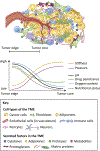The Interplay of the Extracellular Matrix and Stromal Cells as a Drug Target in Stroma-Rich Cancers
- PMID: 32014341
- PMCID: PMC8812124
- DOI: 10.1016/j.tips.2020.01.001
The Interplay of the Extracellular Matrix and Stromal Cells as a Drug Target in Stroma-Rich Cancers
Abstract
The tumor microenvironment (TME) is a complex neighborhood that consists of immune cells, fibroblasts, pericytes, adipocytes, endothelial and neuronal cells, and the extracellular matrix proteins. TME also consists of physical factors, such as oxygen availability, changing pH, interstitial fluid pressure, and tissue stiffness. As cancer progresses, the physical properties and the cells in the TME change significantly, impacting the efficacy of the therapies and modulating drug resistance. This has led to the development of several new treatments targeting the TME. This review focuses on recent advances on the role of TME in drug resistance, with a particular focus on the ongoing clinical trials aiming at disrupting the TME- and the extracellular matrix-mediated protection against therapies.
Keywords: cancer-associated fibroblasts; clinical trials; drug resistance; extracellular matrix; stroma-cancer crosstalk; tumor microenvironment.
Copyright © 2020 Elsevier Ltd. All rights reserved.
Figures


Similar articles
-
Taking a Full Snapshot of Cancer Biology: Deciphering the Tumor Microenvironment for Effective Cancer Therapy in the Oncology Clinic.OMICS. 2020 Apr;24(4):175-179. doi: 10.1089/omi.2020.0019. Epub 2020 Mar 13. OMICS. 2020. PMID: 32176591 Review.
-
The role of matrix stiffness in cancer stromal cell fate and targeting therapeutic strategies.Acta Biomater. 2022 Sep 15;150:34-47. doi: 10.1016/j.actbio.2022.08.005. Epub 2022 Aug 7. Acta Biomater. 2022. PMID: 35948177 Review.
-
Nanoparticle-Mediated Targeted Drug Delivery to Remodel Tumor Microenvironment for Cancer Therapy.Int J Nanomedicine. 2021 Aug 25;16:5811-5829. doi: 10.2147/IJN.S321416. eCollection 2021. Int J Nanomedicine. 2021. PMID: 34471353 Free PMC article. Review.
-
The tumor microenvironment as driver of stemness and therapeutic resistance in breast cancer: New challenges and therapeutic opportunities.Cell Oncol (Dordr). 2021 Dec;44(6):1209-1229. doi: 10.1007/s13402-021-00634-9. Epub 2021 Sep 16. Cell Oncol (Dordr). 2021. PMID: 34528143 Review.
-
The emerging roles of exosomes in anti-cancer drug resistance and tumor progression: An insight towards tumor-microenvironment interaction.Biochim Biophys Acta Rev Cancer. 2021 Jan;1875(1):188488. doi: 10.1016/j.bbcan.2020.188488. Epub 2020 Nov 30. Biochim Biophys Acta Rev Cancer. 2021. PMID: 33271308 Review.
Cited by
-
Stromal disruption facilitating invasion of a 'nano-arsenal' into the solid tumor.Drug Discov Today. 2022 Apr;27(4):1132-1141. doi: 10.1016/j.drudis.2021.11.015. Epub 2021 Nov 22. Drug Discov Today. 2022. PMID: 34823002 Free PMC article. Review.
-
Targeting pyroptosis for cancer immunotherapy: mechanistic insights and clinical perspectives.Mol Cancer. 2025 May 3;24(1):131. doi: 10.1186/s12943-025-02344-4. Mol Cancer. 2025. PMID: 40319304 Free PMC article. Review.
-
Bridging the Gap in Breast Cancer Dormancy: Models, Mechanisms, and Translational Challenges.Pharmaceuticals (Basel). 2025 Jun 26;18(7):961. doi: 10.3390/ph18070961. Pharmaceuticals (Basel). 2025. PMID: 40732251 Free PMC article. Review.
-
Molecular mechanisms of pyroptosis and its role in anti-tumor immunity.Int J Biol Sci. 2023 Aug 6;19(13):4166-4180. doi: 10.7150/ijbs.86855. eCollection 2023. Int J Biol Sci. 2023. PMID: 37705746 Free PMC article. Review.
-
Forcing the code: tension modulates signaling to drive morphogenesis and malignancy.Genes Dev. 2025 Jan 7;39(1-2):163-181. doi: 10.1101/gad.352110.124. Genes Dev. 2025. PMID: 39638568 Free PMC article. Review.
References
-
- Sousa CM, Biancur DE, Wang X, Halbrook CJ, Sherman MH, Zhang L, Kremer D, Hwang RF, Witkiewicz AK, Ying H, Asara JM, Evans RM, Cantley LC, Lyssiotis CA, and Kimmelman AC, Pancreatic stellate cells support tumour metabolism through autophagic alanine secretion. Nature, 2016. 536(7617): p. 479–83. - PMC - PubMed
-
- Auciello FR, Bulusu V, Oon C, Tait-Mulder J, Berry M, Bhattacharyya S, Tumanov S, Allen-Petersen BL, Link J, Kendsersky ND, Vringer E, Schug M, Novo D, Hwang RF, Evans RM, Nixon C, Dorrell C, Morton JP, Norman JC, Sears RC, Kamphorst JJ, and Sherman MH, A Stromal Lysolipid-Autotaxin Signaling Axis Promotes Pancreatic Tumor Progression. Cancer Discov, 2019. 9(5): p. 617–627. - PMC - PubMed
-
- Halbrook CJ, Pontious C, Kovalenko I, Lapienyte L, Dreyer S, Lee HJ, Thurston G, Zhang Y, Lazarus J, Sajjakulnukit P, Hong HS, Kremer DM, Nelson BS, Kemp S, Zhang L, Chang D, Biankin A, Shi J, Frankel TL, Crawford HC, Morton JP, Pasca di Magliano M, and Lyssiotis CA, Macrophage-Released Pyrimidines Inhibit Gemcitabine Therapy in Pancreatic Cancer. Cell Metab, 2019. 29(6): p. 1390–1399 e6. - PMC - PubMed
-
- Mizutani Y, Kobayashi H, Iida T, Asai N, Masamune A, Hara A, Esaki N, Ushida K, Mii S, Shiraki Y, Ando K, Weng L, Ishihara S, Ponik SM, Conklin MW, Haga H, Nagasaka A, Miyata T, Matsuyama M, Kobayashi T, Fujii T, Yamada S, Yamaguchi J, Wang T, Woods SL, Worthley D, Shimamura T, Fujishiro M, Hirooka Y, Takahashi M, and Enomoto A, Meflin-positive cancer-associated fibroblasts inhibit pancreatic carcinogenesis. Cancer Res, 2019. - PubMed
Publication types
MeSH terms
Substances
Grants and funding
LinkOut - more resources
Full Text Sources
Medical
Research Materials

